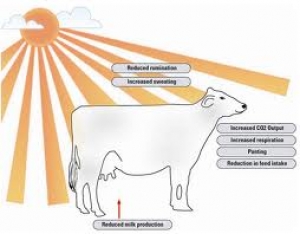Heat stress and cooling systems for dairy cows
Excessive heat load

As heat load builds, the cow becomes increasingly uncomfortable and heat stressed. If a cow is carrying
an excessive heat load for a long time and does not encounter conditions that allow high rates of heat
transfer to occur, then eventually the cow will die. It is important you can recognise the signs of excessive
heat load, so that practical strategies can be developed to help cows cope.
Observable signs of excessive heat load

As heat load builds, the cow’s body struggles to cope. You can use your observations to make judgements about how serious the problem is and decide when to take action.
Internal responses to excessive heat load
Apart from observable changes in behaviour, there are also a number of physiological changes that occur within the cow unseen:
- feed intake decreases by 10-20% when the air temperature is more than 26°C;
- core body temperature rises;
- blood hormone concentrations are changed; and
- blood flow distribution is altered – blood flow to gut, uterus and other internal organs is descreased,
blood flow to skin is increased.
There is no doubt that heat can have disastrous effects on the productivity, health and welfare of cows – whether you can see it or not.






















